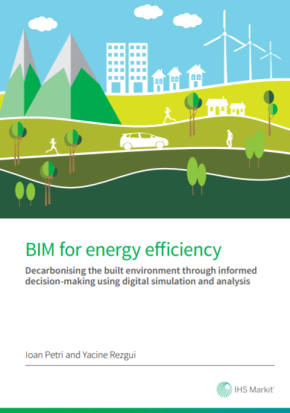BIM for Energy Efficiency (EP107)
BIM for Energy Efficiency (EP107) Decarbonising the built environment through informed decision-making using digital simulation and analysis, was published by BRE on 23 December 2019. It was written by Ioan Petri and Yacine Rezgui, University of Cardiff.
Global warming is driving the need to reduce energy consumption in buildings. The construction sector accounts for more than 40% of Europe’s energy and CO2 emissions. A game-changing strategy is required to support the transition to cleaner and more cost-efficient practices.
Building information modelling (BIM) is already enabling effective collaboration across disciplines with a focus on the total life cycle and supply chain integration. Informed implementation of BIM has the potential to pave the way for energy savings through better supervision of energy flows and a new value proposition during the operational stage.
BIM for Energy Efficiency describes a pioneering study that contributes to the in-depth understanding of BIM engineering issues, covering the complete environmental and building life cycle, including energy efficient design, construction and operation. It provides a fully-integrated theoretical and practical guide to BIM for energy efficiency, with an emphasis on the orchestration of the whole built environment through informed interventions.
The book explores ways in which:
- BIM data can be shared across supply chains and the life cycle, taking into account a wide range of organisational, technical and legal aspects, including information sensitivity.
- BIM can assist in the operational management of buildings and, in particular, help to address the performance gap experienced in existing and new buildings, using artificial intelligence.
- BIM can be used to enforce regulatory compliance with a focus on energy-related regulations.
- BIM for energy efficiency can be scaled up to district and city level.
The contents are:
- Introduction.
- BIM and energy efficiency.
- Best practice and gaps in the use of BIM for energy efficiency in industry.
- Coordinating BIM energy-related data across the supply chain and life cycle.
- BIM-based energy performance management of buildings.
- BIM as a means to streamlining access to sustainability-related information and knowledge.
- BIM for energy regulatory compliance checking.
- Scaling up BIM for energy efficiency to district level.
- Conclusions.
- References.
The book is available at: https://www.brebookshop.com/details.jsp?id=328035
[edit] Related articles on Designing Buildings Wiki
BIM Directory
[edit] Building Information Modelling (BIM)
[edit] Information Requirements
Employer's Information Requirements (EIR)
Organisational Information Requirements (OIR)
Asset Information Requirements (AIR)
[edit] Information Models
Project Information Model (PIM)
[edit] Collaborative Practices
Industry Foundation Classes (IFC)








